With the mocktail movement in full swing, crafting non-alcoholic drinks is a need-to-know skill. Whether you’re taking time off from booze or serving a drink to a friend who isn’t drinking alcohol, there is more to the world of mocktails than just the Shirley Temple drink.

Non-alcoholic drinks are more popular than ever. Thanks to the growing trend of non-alcoholic options in bars and restaurants and more no-drinking challenges like Dry January, many people are enjoying mocktails more often.
Learning how to cater to this trend to craft delicious non-alcoholic beverages is key to being a great host and home bartender. If you’re throwing a party, offering non-alcoholic options to guests is important — you never know who isn’t drinking.
It’s easy to write off mocktails — a portmanteau of the phrase ‘mock cocktails’ — as sugary, sweet and over-the-top, but there’s a lot more to non-alcoholic beverages than sodas and syrups. Don’t miss out on flavor and creativity when crafting delicious non-alcoholic beverages.
Understanding flavor profiles
When making mocktails at home, balancing the sweet, sour, bitter and savory flavors is key to making harmonious sips. Without considering each ingredient and how it contributes to the overall taste, you may wind up with an unbalanced, overly sweet or sour drink.
Many mocktails start with a sweet syrup with soda on top. The nostalgic favorite Shirley Temple drink is one example featuring grenadine syrup and ginger ale or lemon-lime soda.
The Italian soda is similar, taking a fruity simple syrup and topping it with soda water to create unique soda flavors. You can even add a splash of milk or cream, making it a French soda.
Beyond sweet drinks, there are many ways to bring flavor to your drinks. From zero-proof spirits to non-alcoholic bitters, crafting non-alcoholic drinks that taste good has never been easier.

Key ingredients for non-alcoholic drinks
Experiment with different ingredients to achieve your desired flavor profile. Making mocktail ingredients at home makes the drinks taste fresher.
- Fresh ingredients: Using produce like fresh fruits and fragrant herbs can instantly elevate a drink. They can be muddled to release juices, run through a juicer or made into syrups. Zesty citrus fruits especially help to balance sweetness.
- Simple syrups: Making your own syrups with creative flavor combinations is a great base for many cocktails. They start with a sugar and water base but can be infused with fruits, extracts, herbs and edible flowers.
- Cocktail mixers: Most cocktail mixers are sold in a non-alcoholic form, intended to be mixed with alcohol later. But you can also use them in mocktails, such as using margarita mix to make a virgin margarita.
- Non-alcoholic bitters: Regular cocktail bitters have an alcoholic base, so some drinkers may prefer to use a non-alcoholic substitute. Brands like All the Bitter sell craft creations that bring the flavor of bitters without the booze into your home bar.
“I like to use seasonal ingredients in my mocktails to complement the meal I’m serving. In the summer, I will pick ingredients like watermelon or peach, while in the winter, I will pick ingredients like apples or cranberries. Pairing the flavors of your mocktails with your food is key.”
— Gen La Rocca, Two Cloves Kitchen

Alcohol substitutes
Eliminating alcohol from some cocktail recipes can make a delicious drink. But in some cases, it may work better to substitute the alcohol to keep the drink balanced.
Alcohol can provide sweet, bitter and herbal flavors in a drink, and, many times, they are the core flavor. Emulating alcohol in spirit-forward cocktails like the gin and tonic or the old-fashioned used to be difficult, but it’s getting easier thanks to creative homemade substitutes and store-bought solutions.
Designed to emulate the flavor of alcohol, non-alcoholic spirits are a must for mocktail makers. They are brewed with complex flavor profiles and can be used as a 1 to 1 substitute for alcohol.
Flavored water can be a mocktail all on its own. However, you can also use it as a cocktail mixer and infuse your own combinations with fruits, herbs, spices and edible flowers.
With bitterness at their core, coffee and tea can also be used in mocktails. You can sometimes find barrel-aged versions, which give these drinks the woody notes you’d normally find in whiskey or wine.
Vinegar is another option, bringing acidity and tartness to a drink. You could add a splash of balsamic vinegar to some drinks to increase their complexity. Experiment with small amounts of regular, white or flavored balsamic vinegar in your drinks to experience the range of flavors.
Similarly, shrubs are sweet drinking vinegars that can be a delicious base for a mocktail. Kombucha, a type of fermented tea, can also provide a tangy flavor and a fizzy texture to drinks. However, kombucha does contain trace amounts of alcohol, which is something to be aware of.

Easy mocktail recipes
A great place to start is working with zero-proof spirits instead of alcohol to recreate your favorite cocktails. Adding non-alcoholic gin or vodka to a virgin bloody mary or non-alcoholic whiskey to a virgin mint julep makes these drinks taste more like the real deal.
You can also transform the golden ratio of cocktails — 2 ounces spirit, 1 ounce sour, 1 ounce sweet — to a non-alcoholic version by swapping the alcohol for a zero-proof spirit or other alcohol substitute. The sour ingredient usually consists of citrus or other fruit juice, while a simple syrup or other sweetener comprises the sweet element.
Tips for customizing non-alcoholic drinks
When designing your own mocktails, there are a few things to consider beyond flavor. Texture, temperature and garnishes can help you level up your mocktail game.
Experiment with texture. Fizzy drinks like non-alcoholic sparkling wine, club soda or other sodas create a bubbly experience. Shaking ingredients with an egg white or aquafaba will give the drink a smooth, thick texture.
Temperature is another element to play with. Scoops of ice cream and sorbet make a beautiful presentation. Blending a drink with ice also makes for a fun drinking experience, such as a frozen virgin daiquiri. Or, you could try warm drinks with hot chocolate, coffee and tea bases.
Finally, add a garnish to finish things off. Whether it’s a salt or sugar rim on the glass, a cherry on a cocktail pick or an elegant lemon twist on top of the drink, garnishes can add extra flavor and fragrance to a drink, not to mention good looks. A garnish makes a drink feel professional and complete, mimicking the cocktail experience — without the booze.
Based in Charlotte, N.C., Susannah Brinkley Henry is the cocktail content creator behind the blog Feast + West. Her work has been featured in Southern Living, Oprah Daily, Buzzfeed, and more. In 2019, her website was a finalist in the Saveur Blog Awards for Best Entertaining Blog. As a professional graphic designer, photographer, writer, and recipe developer, Susannah helps home bartenders and drink enthusiasts level up their cocktail skills.